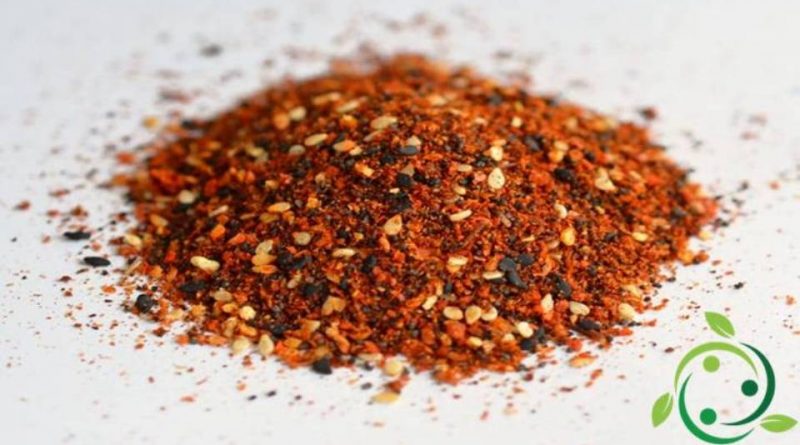Shichimi tōgarashi
Shichimi tōgarashi
Shichimi tōgarashi or simply shichimi (Japanese: 七味 唐辛 子) is a mixture of traditional spices of Japanese cuisine.
Origins and History –
Shichimi tōgarashi which in its original Japanese language literally means “seven-flavor chili” is a traditional blend of spices which, outside of Japan, is also known as nanami tōgarashi.
Shichimi tōgarashi is usually prepared at home and kept cool. It is widely used in soups, tagliolini, white meat dishes and various rice dishes, such as rice cakes, agemochi and rice crackers.
As the name suggests, it is made up of seven ingredients; the main of which is a type of red pepper called togarashi, to which are added: mandarin zest (which gives it its typical orange color), sesame seeds (in some recipes black sesame is preferred), poppy seeds, seeds of hemp, chopped nori seaweed, Sichuan pepper. In some areas hemp is replaced by ginger or chopped garlic. In some variants, rapeseed, ginger or licorice are added.
The origin of this ancient Japanese blend dates back at least 400 years; probably originates among the apothecaries of the 17th century, when chillies were introduced to Japan as a form of medicine.
Description –
Shichimi tōgarashi is a spice mixture born in Japan made on the basis of a particular type of chili, which is tōgarashi, to which are added tangerine peel, sesame or black sesame seeds, poppy seeds, hemp seeds, seaweed chopped nori, Sichuan pepper. Some variants, also linked to particular geographical areas, require that hemp be replaced by ginger or chopped garlic and rapeseed, ginger or licorice can still be added.
The mixture takes on an intense orange color, both for the chillies but above all for the tangerine peel, with visible sesame seeds, hemp seeds. The consistency and seeds powdery.
Active principles –
The nutritional values of Shichimi tōgarashi are linked to the percentages that are used of the individual components which, as is evident, depends very much on the starting raw materials, so there is no standard data sheet of the nutritional values and substances present in this spice.
This is due not so much to the variability of the components of Shichimi tōgarashi but also to the variety of ingredients and also to the difference in characteristics, often of the spices that make it up, as they also come from somewhat different cultivation systems.
Properties and Uses –
Shichimi tōgarashi is a mixture of spices typical of traditional Japanese cuisine.
In the past it was prepared at home and stored in the fridge to be ready for use, while today it is almost always bought at the supermarket.
It is used to flavor soups, white meat dishes and various rice-based dishes, such as agemochi and rice crackers.
As mentioned, seven ingredients are used to prepare it, the basic ingredient is togarashi red pepper, to which are added, mandarin zest, white or black sesame seeds, poppy seeds, hemp seeds, chopped nori seaweed, pepper of Sichuan.
In some local variants, hemp is replaced by ginger or chopped garlic, while in others even licorice is added to give it a more aromatic sense.
This particular spice, of Asian origin, gives absolutely delicious notes to the dishes, in particular for the grilled meats, pasta, rice and soups that characterize Japanese cuisine so much.
It can be said that it is an unusually spicy flavor by Japanese standards, even if it is very diluted by the fruity fragrances that stop the sense of spiciness: citrus touches and oceanic algae. While ginger, Sichuan pepper and sesame seeds add flavor notes to make this blend extremely versatile.
Preparations –
Since this mixture of spices and aromas is based on many flavors, it becomes an ideal condiment for soup rice, first courses and grilled meat dishes.
Its main use is precisely on meat: it is used to massage the meat and form a thin appetizing crust during cooking.
Among the various meat dishes, it can be used to prepare beef skewers, tuna steaks, hamburgers or chicken wings, perhaps after marinating in soy and garlic sauce.
It can also be used to flavor accompanying creams and sauces or to give an exotic touch to pasta and rice in white with the addition of sliced shallots and sesame oil.
Guido Bissanti
Warning: The information shown is not medical advice and may not be accurate. The contents are for illustrative purposes only and do not replace medical advice.

